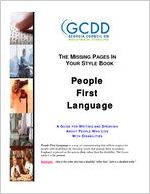THE MISSING PAGES IN YOUR STYLE BOOK
People First
Language
A GUIDE FOR WRITING AND SPEAKING ABOUT PEOPLE WHO LIVE WITH DISABILITIES
People First Language is a way of communicating that reflects respect for people with disabilities by choosing words that portray them accurately. Emphasis is placed on the person first, rather than the disability. The focus/ subject is the person. Example: "John is the writer who has a disability" rather than "John is a disabled writer."
The Missing Page in your Stylebook: People-First Language
A project of the Georgia Council on Developmental Disabilities
Distinction between Disability and Handicap++
A Disability is a condition caused by an accident, trauma, genetics or disease, which may limit a person's mobility, hearing, vision, speech or mental function. Some people with disabilities have more than one disability.
A Handicap is a physical or attitudinal constraint that is imposed upon a person, regardless of whether that person has a disability. Webster's defines handicap as "to put at a disadvantage."
Example: Some people with disabilities use wheelchairs. Stairs, narrow doorways and curbs are handicaps imposed upon people who use wheelchairs. ++ Disability Handbook, City of San Antonio, TX. www.sanantonio.gov/planning/ disability_handbook/deh1.asp
Tips for reporting on people with disabilities**
Do not focus on disability unless it is crucial to a story. Focus instead on issues that affect the quality of life of those same individuals, such as accessible transportation, housing, affordable health care, employment opportunities, or discrimination.
Do not portray successful people with disabilities as superhuman. This raises false expectations that all people with disabilities should be high achievers.
Do not sensationalize a disability by using such language as "afflicted with," "crippled," "suffers from," "confined to a wheelchair, wheelchair-bound" etc.
Do not use generic labels for disability groups such as "the retarded" or "the deaf."
Do not define individuals by their disability. Put People First, not their disability.
Emphasize abilities, not limitations. Show people as active participants in society.
After the first People First Language reference, it's alright to use "disabled person" as a secondary reference.
Do not use euphemisms to describe a disability.
** University of Kansas, Publications, Research and Training Center on Independent Living
People-First Language Preferred Expressions:
Say/Write...
Child with a disability Individual with cerebral palsy Person who has.... Nonverbal (with speech) Child(ren) with autism Developmental delay Emotional disorder/mental illness Deaf or has a hearing impairment Communicates with sign language Uses a wheelchair Has a cognitive; with disabilities He has epilepsy Adult with Down syndrome Has a learning disability Has a physical disability Non-disabled Congenital disability Condition Seizures Cleft lip Has mobility impairment Paralyzed Has quadriplegia Has paraplegia
Instead of...
handicapped or disabled palsied, CP or spastic Afflicted, suffers from, victim of mute or dumb autistic slow or retarded crazy or insane deaf and dumb signer confined to a wheelchair retarded epileptic mongoloid, suffers from Down syndrome is learning disabled is physically disabled/crippled normal, healthy birth defect disease (unless it IS) fits hare lip lame or crippled invalid or paralytic quadriplegic paraplegic
Thank you for your time and willingness to hear about creating true inclusion and diversity. We hope that you will help make a difference for family members, friends, neighbors and co-workers who live with disabilities by using People First Language and encourage others to do the same. Our goal is to change public perception and create more welcoming attitudes through the words we choose. By placing emphasis on the person first, we enhance our communities because everyone knows they count!
People First Language:
These words and expressions are currently preferred and reflect a positive attitude. Some language is "trendy" and meanings may vary depending on the context. The ideal is to incorporate these words into our language in a way that first and foremost, expresses the dignity of the person.
Blind; blindness Low vision; person with low vision Vision impaired Disabled (secondary reference) Person with cerebral palsy Person with a disability Person with developmental disabilities; developmentally disabled Person with paraplegia Psychological/emotional disability Wheelchair-user or uses a wheelchair
Not all people with disabilities agree on which language or terminology is preferred like any other large, yet identifiable group of people. Individuals will vary as to how they refer to themselves and how they would like you to refer to them.
Valerie Meadows Suber, Public Information Director Georgia Council on Developmental Disabilities (404) 657-2122 | vmsuber@dhr.state.ga.us
2 Peachtree Street, NW Suite 26-246 . Atlanta, Georgia 30303 (888)ASK-GCDD . (404) 657-2126 . TDD (404) 657-2133.
http://www.gcdd.org
